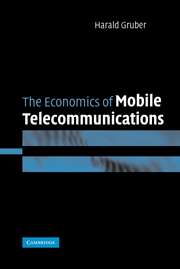Book contents
- Frontmatter
- Contents
- List of figures
- List of tables
- Preface
- List of abbreviations and acronyms
- 1 Introduction
- 2 Stylised features of the mobile telecommunications industry
- 3 The evolution of national markets for cellular mobile telecommunications services
- 4 The determinants of the diffusion of cellular mobile telecommunications services
- 5 Market conduct and pricing issues in mobile markets
- 6 Issues in radio spectrum management
- 7 The evolution of market structure in mobile telecommunications markets
- Appendix
- Bibliography
- Index
6 - Issues in radio spectrum management
Published online by Cambridge University Press: 22 September 2009
- Frontmatter
- Contents
- List of figures
- List of tables
- Preface
- List of abbreviations and acronyms
- 1 Introduction
- 2 Stylised features of the mobile telecommunications industry
- 3 The evolution of national markets for cellular mobile telecommunications services
- 4 The determinants of the diffusion of cellular mobile telecommunications services
- 5 Market conduct and pricing issues in mobile markets
- 6 Issues in radio spectrum management
- 7 The evolution of market structure in mobile telecommunications markets
- Appendix
- Bibliography
- Index
Summary
Introduction
Radio spectrum is a scarce, but indispensable, input in the provision of mobile telecommunications services. Because of the externalities in spectrum usage such as electromagnetic interference and compatibility of equipment, the allocation of spectrum needs to be coordinated both across countries and within countries. Whereas the international allocation of spectrum is taking place in periodic institutional meetings whose nature has not changed much over three decades, a fundamental change has occurred at the national level where frequencies are assigned to individual firms. The changes mainly concern the method of assignment, with a shift from administrative procedures toward so-called ‘market-based mechanisms’. These changes have implications for both the market structure and performance of the mobile telecommunications industry.
Section 6.2 illustrates the international aspects of radio spectrum management, dealing with the allocation of frequencies for different types of wireless communication services. Section 6.3 moves to the national context and describes various methods of assigning radio spectrum to firms. This also includes a theoretical examination of auction theory, illustrating the assumptions under which the most desirable properties of this method actually apply. Section 6.4 describes the spectrum assignment method in practice, by referring to country-specific contexts. Sections 6.5–6.7 describe actual assignment procedures for radio spectrum for 3G mobile telecommunications services in several European countries. Section 6.8 draws some brief conclusions.
International spectrum allocation
The electromagnetic frequencies suitable for wireless radio transmission are limited to a subset of frequencies of the radio spectrum.
- Type
- Chapter
- Information
- The Economics of Mobile Telecommunications , pp. 223 - 265Publisher: Cambridge University PressPrint publication year: 2005



